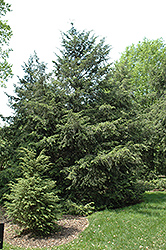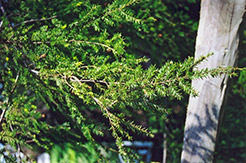Height: 60 feet
Spread: 30 feet
Sunlight:
![]()
![]()
![]()
Hardiness Zone: 3
Other Names: Eastern Hemlock
Description:
A delicate and beautiful conifer of the Eastern forests, with soft needles and an open habit of growth, upright and broadly conical, also makes a great hedge; needs adequate moisture, rich, acidic and organic soils and shelter from drying winds
Ornamental Features
Canadian Hemlock is primarily valued in the landscape for its distinctively pyramidal habit of growth. It has dark green evergreen foliage which emerges light green in spring. The needles remain dark green throughout the winter.
Landscape Attributes
Canadian Hemlock is an evergreen tree with a strong central leader and a distinctive and refined pyramidal form. It lends an extremely fine and delicate texture to the landscape composition which can make it a great accent feature on this basis alone.
This tree will require occasional maintenance and upkeep, and is best pruned in late winter once the threat of extreme cold has passed. Gardeners should be aware of the following characteristic(s) that may warrant special consideration;
- Insects
Canadian Hemlock is recommended for the following landscape applications;
- Vertical Accent
- Hedges/Screening
Planting & Growing
Canadian Hemlock will grow to be about 60 feet tall at maturity, with a spread of 30 feet. It has a low canopy with a typical clearance of 3 feet from the ground, and should not be planted underneath power lines. It grows at a medium rate, and under ideal conditions can be expected to live for 70 years or more.
This tree performs well in both full sun and full shade. It does best in average to evenly moist conditions, but will not tolerate standing water. It is not particular as to soil type, but has a definite preference for acidic soils. It is quite intolerant of urban pollution, therefore inner city or urban streetside plantings are best avoided, and will benefit from being planted in a relatively sheltered location. Consider applying a thick mulch around the root zone in winter to protect it in exposed locations or colder microclimates. This species is native to parts of North America.
How can we help?
We encourage you to visit the garden center to explore our full offerings and connect with our team of experts. Our team is on hand to help with any questions you have, and can help you with memorials, deliveries, special orders, and tree planting and more…





